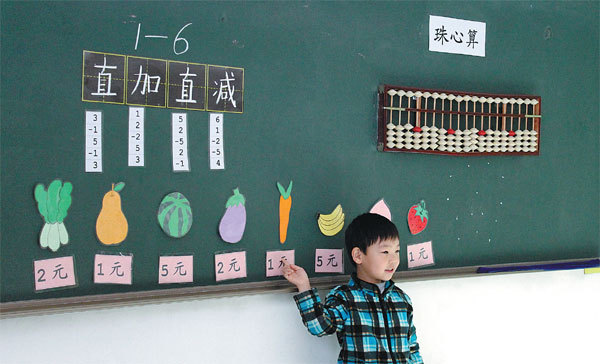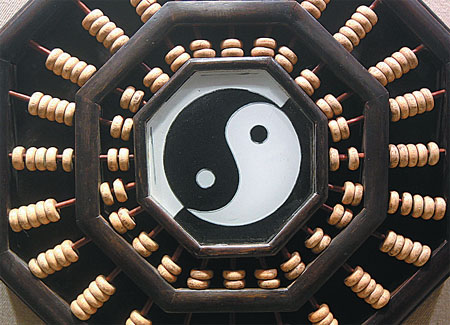|
The world is recalculating the abacus' added historical and contemporary value since the device was inscribed on the UNESCO World Heritage List last month. Xu Lin reports.
New interest in the ancient abacus can be seen on a preschool's blackboard, which is covered with photos of fruit with price tags and the ancient calculation device.
And it can be heard in the click-clack of children sliding abacus beads to answer teacher Zhang Jing's question: "How much would two bananas and three oranges cost?"
Tian Xingjian loves the class at the preschool attached to the Beijing Bright Horizon International Academy primary school, largely because of the playful pedagogical approach.
"It's very fun!" the 5-year-old says.
"I love all the games. I've learned how to buy things and calculate with an abacus."
The preschool is among the city's few that offer abacus classes. The two 40-minute classes a week use games to help students learn - and enjoy doing so.
"The numbers 1, 2, 3 are abstract to them," Zhang says. "It's easier for them to understand apples and pears. It arouses their interest in math."
Zhang believes merely memorizing and practicing abacus procedures would be too boring.
Tian's mother, Hu Hui, says the method has worked.
"(My son) has become more interested in math," says Hu, who works in finance.
"The abacus makes both his fingers and mind nimbler. He likes to play the fruit game at home in which he sells things and calculates prices."
The United Nations Educational, Scientific and Cultural Organization announced in early December that the traditional use of the Chinese abacus, or zhusuan, ranks among 25 new World Intangible Cultural Heritage List entries.
The innovation is acclaimed as humankind's "first computer".
It was widely used in China for more than a millennium, since its invention between 1,800 and 3,000 years ago. But its use was obscured by technological developments more than a decade ago since the electronic calculator became widely available.
Abacus courses were compulsory in Chinese primary schools until 2001, when the Ministry of Education subtracted abacus requirements from its Compulsory Education Mathematics Curriculum Standard. Abacus lessons gradually disappeared from colleges and universities, too.
In about a decade, the abacus went from a necessary skill to a math-instruction tool for select primary schools and kindergartens.
A five-year National Institute of Education Sciences study ending in 2009 found abacus education clearly boosts elementary school students' overall intellectual development. It builds IQ, memory, attention span, and problem-solving and presentation skills. It also benefits preschoolers, the research found.
Beijing Bright Horizon International Academy's principal Liu Liquan says the device has shown results in helping young kids learn math.
He says the school trained teachers after discovering a lack of standardization in their abacus lessons.
"They must realize it's only an auxiliary tool to learn math," he says. "It's not a skill we require kids to master to any certain level."
Lessons' availability diffuses outside first-tier cities.
Anhui province's Hefei Shilimiao Primary School is the only school in the provincial capital with abacus lessons.
It offered the course as an extracurricular class from 1995 until it became required from grades 1 to 4, who can also take additional extracurricular abacus classes, in 2009.
Students start mornings with a special regimen the school developed in which they hold their abacuses while performing fitness routines.
They also learn to do "mental abacus arithmetic", in which they visualize an abacus executing calculations in their mind's eye.
Headmaster Li Yanhao says first-grade students who take the extracurricular class can perform incredible arithmetic on the device. He claims some can add and subtract a dozen three-digit, round numbers.
Li is glad UNESCO inscribed the abacus.
"We should preserve our tradition," he says. "It's good for mathematics. And it doesn't affect other classes."
Yet while extolling the abacus' virtues and use in their school's curriculum, Li and Liu are reserved about the view the UNESCO proclamation should spur the re-introduction of abacus classes in all primary schools.
"The calculator rendered it obsolete," Liu says. "We should inherit culture but not make tradition the core."
The abacus' pedagogical efficacy extends to special education in China.
Dongli Fengmei Kangjian School has more than 200 intermediately or severely developmentally challenged students ages 7-16, who study the device. The school offers nine-year compulsory education for children with learning disabilities. Shanghai's Xuhui district government founded the school in 1994.
It was initially difficult for the school to offer math courses because there were no appropriate textbooks and few resources.
The school began cooperating with the Shanghai Abacus and Mental Arithmetic Association after the association began researching abacus lessons' impacts in 1997.
"We use abacuses all the time to teach math," says Yang Jian, head of the mathematics instruction and research group. "The abacus is a kid's best friend."
She says it's helpful for autistic children, who like patterns and can't comprehend complicated instructions. The abacus operates according to simple and clear procedures. Its formulas are pithy and systematic. Autistic kids are sensitive to auditory stimulation, so the beads' clacks fascinate them.
Yang says children with Down syndrome like to imitate others, including those who use abacuses. Repeating formulas with teachers also enhances their speaking.
The abacus proves difficult for such children, who can only perform very simple calculations. But the course focuses on teaching them greater independence, Yang says.
"Parents worry that it's difficult for their kids to learn to calculate," she says.
"The abacus helps them learn math fast. We have a lot of time to teach them how to use calculations in real life."
Teachers use abacuses to teach students to identify the yuan's nominal values, and determine and compare prices.
They also take students to markets to shop and to dine in a restaurant, so they can put what they've learned into practice.
Wang Hai says the abacus has done wonders for her 9-year-old daughter, who has Down syndrome.
"I taught my girl the numbers from 1 to 10 for two years, but she couldn't quite get it," says Wang, who works in the foreign trade sector in Shanghai.

"But she started making rapid progress since she began learning the abacus. She can even do some simple calculations."
Qian Qing, a stay-at-home mom whose 11-year-old autistic son studies at the school, says the device helps kids like him better understand numbers and basic calculations.
She takes him to convenience stores every day, so he can buy his favorite snacks and pay on his own.
"We have to help children with special needs understand the rules of buying things, such as lining up," Qian says.
President of the China Abacus and Mental Arithmetic Association Ding Xianjue believes the abacus' World Intangible Cultural Heritage listing is a great opportunity to promote it.
The association will focus on the instruction of children and the combination of the abacus and mathematics.
Ultimately, the UNESCO listing may change the equation and add up to a greater number of people, especially contemporary youth, learning how to use "the world's oldest calculator".
Contact the writer at xulin@chinadaily.com.cn
Sun Li contributed to this story.
 |
|
Tian Xingjian, 5, calculates on the abacus on the blackboard at the preschool attached to the Beijing Bright Horizon International Academy primary school. Xu Lin / China Daily
|
 |
|
A jade abacus with a yin-yang pattern in the center is part of the collection at the China Zhusuan Museum in Nantong in Jiangsu province. Xu Congjun / for China Daily
|
 |
|
Hefei Shilimiao Primary School students start mornings with a special regimen performed with abacuses. Provided to China Daily
|
|